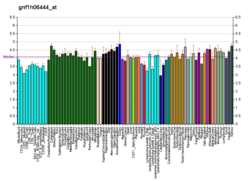Synaptotagmin-9 is a protein that in humans is encoded by the SYT9 gene.
Interactions
SYT9 has been shown to interact with SYNCRIP, TUBB and TRPV1.
References
- ^ GRCh38: Ensembl release 89: ENSG00000170743 – Ensembl, May 2017
- ^ GRCm38: Ensembl release 89: ENSMUSG00000062542 – Ensembl, May 2017
- "Human PubMed Reference:". National Center for Biotechnology Information, U.S. National Library of Medicine.
- "Mouse PubMed Reference:". National Center for Biotechnology Information, U.S. National Library of Medicine.
- Craxton M (Sep 2001). "Genomic analysis of synaptotagmin genes". Genomics. 77 (1–2): 43–9. doi:10.1006/geno.2001.6619. PMID 11543631.
- "Entrez Gene: SYT9 synaptotagmin IX".
- Mizutani A, Fukuda M, Ibata K, Shiraishi Y, Mikoshiba K (Mar 2000). "SYNCRIP, a cytoplasmic counterpart of heterogeneous nuclear ribonucleoprotein R, interacts with ubiquitous synaptotagmin isoforms". The Journal of Biological Chemistry. 275 (13): 9823–31. doi:10.1074/jbc.275.13.9823. PMID 10734137.
- Haberman Y, Grimberg E, Fukuda M, Sagi-Eisenberg R (Nov 2003). "Synaptotagmin IX, a possible linker between the perinuclear endocytic recycling compartment and the microtubules". Journal of Cell Science. 116 (Pt 21): 4307–18. doi:10.1242/jcs.00719. PMID 12966166.
- Morenilla-Palao C, Planells-Cases R, García-Sanz N, Ferrer-Montiel A (Jun 2004). "Regulated exocytosis contributes to protein kinase C potentiation of vanilloid receptor activity". The Journal of Biological Chemistry. 279 (24): 25665–72. doi:10.1074/jbc.M311515200. PMID 15066994.
Further reading
- Rual JF, Venkatesan K, Hao T, Hirozane-Kishikawa T, Dricot A, Li N, Berriz GF, Gibbons FD, Dreze M, Ayivi-Guedehoussou N, Klitgord N, Simon C, Boxem M, Milstein S, Rosenberg J, Goldberg DS, Zhang LV, Wong SL, Franklin G, Li S, Albala JS, Lim J, Fraughton C, Llamosas E, Cevik S, Bex C, Lamesch P, Sikorski RS, Vandenhaute J, Zoghbi HY, Smolyar A, Bosak S, Sequerra R, Doucette-Stamm L, Cusick ME, Hill DE, Roth FP, Vidal M (Oct 2005). "Towards a proteome-scale map of the human protein-protein interaction network". Nature. 437 (7062): 1173–8. Bibcode:2005Natur.437.1173R. doi:10.1038/nature04209. PMID 16189514. S2CID 4427026.
- Morenilla-Palao C, Planells-Cases R, García-Sanz N, Ferrer-Montiel A (Jun 2004). "Regulated exocytosis contributes to protein kinase C potentiation of vanilloid receptor activity". The Journal of Biological Chemistry. 279 (24): 25665–72. doi:10.1074/jbc.M311515200. PMID 15066994.
- Haberman Y, Grimberg E, Fukuda M, Sagi-Eisenberg R (Nov 2003). "Synaptotagmin IX, a possible linker between the perinuclear endocytic recycling compartment and the microtubules". Journal of Cell Science. 116 (Pt 21): 4307–18. doi:10.1242/jcs.00719. PMID 12966166.
\* Dubois T, Howell S, Zemlickova E, Aitken A (Apr 2002). "Identification of casein kinase Ialpha interacting protein partners". FEBS Letters. 517 (1–3): 167–71. Bibcode:2002FEBSL.517..167D. doi:10.1016/S0014-5793(02)02614-5. PMID 12062430. S2CID 84792445.
- Zhang X, Kim-Miller MJ, Fukuda M, Kowalchyk JA, Martin TF (May 2002). "Ca2+-dependent synaptotagmin binding to SNAP-25 is essential for Ca2+-triggered exocytosis". Neuron. 34 (4): 599–611. doi:10.1016/S0896-6273(02)00671-2. PMID 12062043. S2CID 16768299.
- Fukuda M, Kowalchyk JA, Zhang X, Martin TF, Mikoshiba K (Feb 2002). "Synaptotagmin IX regulates Ca2+-dependent secretion in PC12 cells". The Journal of Biological Chemistry. 277 (7): 4601–4. doi:10.1074/jbc.C100588200. PMID 11751925.
- Mizutani A, Fukuda M, Ibata K, Shiraishi Y, Mikoshiba K (Mar 2000). "SYNCRIP, a cytoplasmic counterpart of heterogeneous nuclear ribonucleoprotein R, interacts with ubiquitous synaptotagmin isoforms". The Journal of Biological Chemistry. 275 (13): 9823–31. doi:10.1074/jbc.275.13.9823. PMID 10734137.
- Perin MS (Oct 1996). "Mirror image motifs mediate the interaction of the COOH terminus of multiple synaptotagmins with the neurexins and calmodulin". Biochemistry. 35 (43): 13808–16. doi:10.1021/bi960853x. PMID 8901523.
| Membrane protein: vesicular transport proteins (TC 1F) | |||||||||||||||||||||||||||
|---|---|---|---|---|---|---|---|---|---|---|---|---|---|---|---|---|---|---|---|---|---|---|---|---|---|---|---|
| Synaptic vesicle |
| ||||||||||||||||||||||||||
| COPI | |||||||||||||||||||||||||||
| COPII | |||||||||||||||||||||||||||
| RME/Clathrin | |||||||||||||||||||||||||||
| Caveolae | |||||||||||||||||||||||||||
| Other/ungrouped |
| ||||||||||||||||||||||||||
| See also vesicular transport protein disorders | |||||||||||||||||||||||||||
This article on a gene on human chromosome 11 is a stub. You can help Misplaced Pages by expanding it. |




